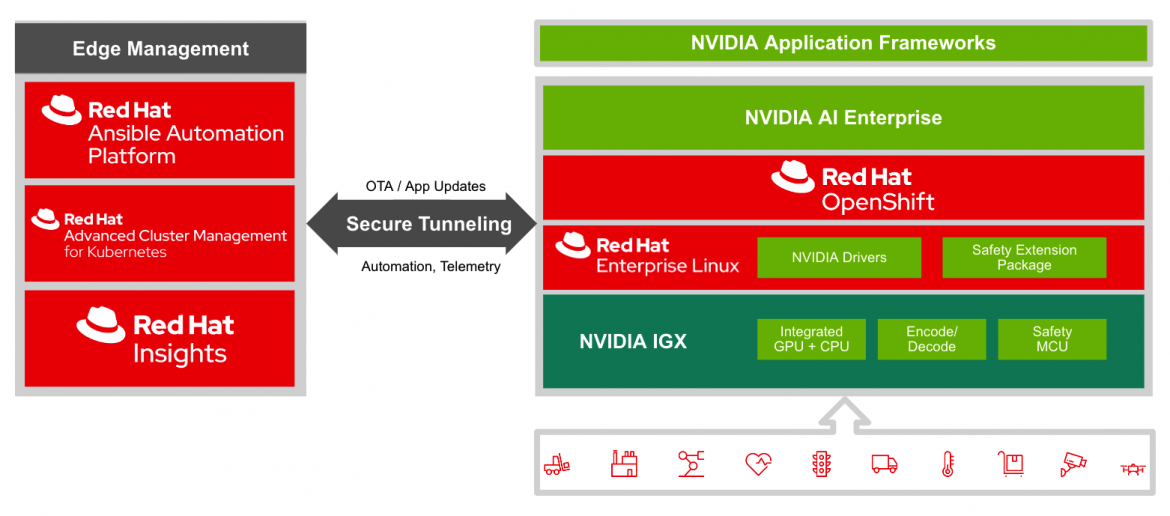红帽博客
Computing at the edge is fueling the need for special-purpose hardware and software infrastructure that complements computational capabilities found in a typical datacenter. The advent of Industry 4.0, the term often used to describe the fourth industrial revolution, has shifted the focus of industrial innovation toward the edge where operational technologies (OT) and traditional IT converge.
This convergence requires organizations to adopt modern, software-defined practices that provide more effective and efficient data analysis closer to the source; implement on-premise artificial intelligence (AI) infrastructure for near real-time predictive analytics; and enable digital twin environments.
This shift is disrupting the traditional manufacturing sector, often requiring hardware and applications with functionality that is specific to certain environments and consistent with processes and certifications common to a particular industry. Moreover, these solutions have to adhere to strict requirements such as zero-trust security, built-in functional safety and long-term support.
Historically, this has been addressed by solutions that were purpose-built for specific
environments or use cases. Today, Red Hat is working alongside IT industry leaders to disrupt the OT segment by applying best practices to help manufacturers better scale, minimize time to market for new and innovative products, and facilitate more efficient production and delivery.
For instance, we're working with NVIDIA to enable organizations to harness the power of accelerated hardware and cloud-native software in industrial settings. The NVIDIA IGX platform is a great example of an integrated design built for software-defined manufacturing environments that offers high performance in a small package. NVIDIA IGX combines a dedicated facility for running critical functional safety operations and software services, the latest-generation NVIDIA GPU for accelerating AI applications, the NVIDIA ConnectX-7 NIC for ultra-fast connectivity and general purpose Arm processor capable of running Red Hat Enterprise Linux and Red Hat OpenShift.
By separating functional safety operations from traditional applications running on general purpose CPUs, this design offers additional protection from malicious software and better isolation from security threats, keeping machine-human interactions as safe as possible in environments where humans and machines work together.

Tracing its lineage to the popular NVIDIA Jetson developer kits, NVIDIA IGX Orin is positioned as the first product offering in the IGX platform, delivering performance in the size and power envelope required for industrial and medical applications.
Red Hat continues to power innovation at the edge by actively working with NVIDIA to bring Red Hat’s edge-focused offerings to this new platform. By adopting the Red Hat portfolio across both IT and OT environments, our customers can benefit from having a consistent user experience while taking advantage of the same set of development tools and processes. Combined with best practices of architecting applications from trusted components, and Red Hat’s software supply chain security patterns, our customers are getting a hardened, enterprise-ready software stack with long-term support that can be used anywhere, from hybrid cloud to the edge.
Key Red Hat Enterprise Linux capabilities that are relevant to industrial edge applications include:
- The ability to create purpose-built operating system images optimized for various edge deployments and applications;
- A single, familiar interface for zero-touch provisioning, system health visibility and quick security remediations;
- Remote device updates with mirroring and transparent staging for maximum uptime;
- Over-the-air (OTA) updates in low bandwidth or limited/intermittent connectivity environments;
- Intelligent rollbacks with health checks that automatically revert to the last good update in case any conflicts or issues are detected.
- Flexible topology options to meet the varying space, power, and connectivity requirements with 3-node clusters of combined control plane and worker nodes, a single node with both the control plane and worker functions, and remote worker configurations where only the worker nodes are deployed at the edge;
- Red Hat Advanced Cluster Management for Kubernetes to manage OT infrastructure and IT clusters with a single, consistent view;
- Zero-touch provisioning for repeatable, automated provisioning of infrastructure that simplifies deployments for non-highly technical personnel.
These attributes can help close the organizational divide between IT and OT, enabling the software that has traditionally stayed in the realm of IT teams to also run on OT systems.
With the NVIDIA IGX platform, Red Hat’s software portfolio can help bridge the gap between IT and OT across many regulated environments with unified systems that can be used by both business and operations teams. Learn more about IT and OT convergence, NVIDIA IGX, and the work Red Hat and NVIDIA are doing together.
About the authors
Ben Breard is a Senior Principal Product Manager at Red Hat, focusing on Red Hat Enterprise Linux and Edge Offerings.
Yan Fisher is a Global evangelist at Red Hat where he extends his expertise in enterprise computing to emerging areas that Red Hat is exploring.


